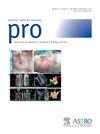Reducing Patient Care Delays in Radiation Oncology Via Optimization of Insurance Preauthorization
IF 3.4
3区 医学
Q2 ONCOLOGY
引用次数: 0
Abstract
Purpose
Difficulties and delays in insurance preauthorization (preauth) can negatively impact patient care, resulting in postponing, modifying, or even canceling radiation therapy for patients. We aimed to perform a root cause analysis for preauth delays in our department and implement solutions to optimize our workflow. Our primary objectives were to decrease the mean time for clinical treatment plan (CTP) completion and the number of cases delayed/denied by 50% each.
Methods and Materials
We performed a root cause analysis for preauth delays and used the Plan, Do, Study, Act, and A3 quality improvement methods. We sampled ∼2 cases per disease site (19 cases from July to August 2022) to determine the baseline. Countermeasures included (1) optimizing our CTP templates per disease site to contain the specific clinical information required for preauth, (2) formalizing earlier completion of CTPs in our Care Path, and (3) formalizing the preauth workflow in our Care Path. We tracked various metrics, including the mean time for CTP completion, the percentage usage of our Care Path, the percentage usage of revised CTP templates, the mean time until preauth was initiated and completed, and the percentage of cases delayed/denied. Two-tailed t tests and χ2 tests were used to generate P values comparing mean values and percentages, respectively.
Results
A total of 495 patients completed computed tomography simulation in our department between October 2022 and February 2023. The mean time for CTP completion (day 0 = day of computed tomography simulation scheduling) improved from 16 days at baseline to 4 days (P < .001). Care Path usage improved from 16% to 97% (P < .001), as did the usage of our revised CTP templates, from 0% to 97% (P < .001). The mean time from insurance preauth initiation to completion improved from 5 days to 1 day. The percentage of cases that were delayed/denied was reduced significantly from 32% to 8% (P < .001).
Conclusions
Improving timeliness and details of CTP documentation and preauth by using our Care Path and optimizing CTP templates improved the efficiency of insurance preauth completion and reduced the number of cases delayed/denied.
通过优化保险预授权减少放射肿瘤学患者护理的延误:通过优化保险预授权减少放射肿瘤科患者护理延误
目的/目标:保险预授权(pre-auth)的困难和延误会对患者护理产生负面影响,导致患者推迟、修改甚至取消放射治疗。我们旨在对本部门预授权延误的根本原因进行分析,并实施优化工作流程的解决方案。我们的主要目标是将完成临床治疗计划(CTP)的平均时间和延迟/拒绝病例的数量各减少 50%:我们采用 PDSA 和 A3 质量改进方法,对批准前延误进行了根本原因分析。我们在每个病区抽取了 2 个病例(2022 年 7 月至 8 月共 19 个病例),以确定基线。对策包括1)优化每个疾病部位的 CTP 模板,使其包含预认证所需的特定临床信息;2)在 Care Path® 中正式规定提前完成 CTP;3)在 Care Path® 中正式规定预认证工作流程。我们跟踪了各种指标,包括完成 CTP 的平均时间、Care Path® 的使用率、修订后的 CTP 模板的使用率、启动和完成预审的平均时间以及延迟/拒绝病例的百分比。双尾 T 检验和卡方检验分别用于比较平均值和百分比的 P 值:2022年10月至2023年2月期间,495名患者在我科完成了CT模拟。CTP完成的平均时间(第0天=CT模拟安排日)从基线时的16天缩短至4天(P结论:通过使用我们的 Care Path® 和优化 CTP 模板,改善了 CTP 文件和预审的及时性和细节,提高了保险预审的完成效率,减少了延迟/拒绝病例的数量。
本文章由计算机程序翻译,如有差异,请以英文原文为准。
求助全文
约1分钟内获得全文
求助全文
来源期刊

Practical Radiation Oncology
Medicine-Radiology, Nuclear Medicine and Imaging
CiteScore
5.20
自引率
6.10%
发文量
177
审稿时长
34 days
期刊介绍:
The overarching mission of Practical Radiation Oncology is to improve the quality of radiation oncology practice. PRO''s purpose is to document the state of current practice, providing background for those in training and continuing education for practitioners, through discussion and illustration of new techniques, evaluation of current practices, and publication of case reports. PRO strives to provide its readers content that emphasizes knowledge "with a purpose." The content of PRO includes:
Original articles focusing on patient safety, quality measurement, or quality improvement initiatives
Original articles focusing on imaging, contouring, target delineation, simulation, treatment planning, immobilization, organ motion, and other practical issues
ASTRO guidelines, position papers, and consensus statements
Essays that highlight enriching personal experiences in caring for cancer patients and their families.
 求助内容:
求助内容: 应助结果提醒方式:
应助结果提醒方式:


